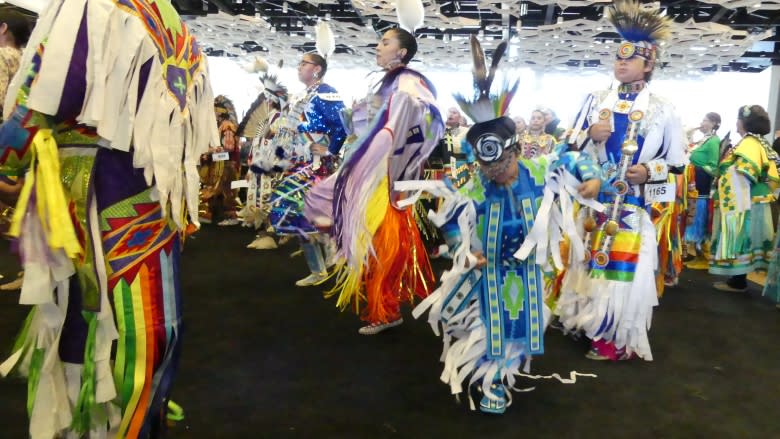Manito Ahbee International Powwow both a reunion and a friendly competition
To the beat of the Big Drum, hundreds of dancers, dressed in colourful regalia, entered the International Powwow at Winnipeg's Manito Ahbee festival Saturday.
The gathering is both a reunion for families and friends across North America and a serious competition among First Nations dancers.
This year 800 dancers, of all ages, compete for prizes totalling $180,000.
Brennah Wahweotten, 21, drove half-a-day to Winnipeg from Mayetta, Kansas. From her earrings to her moccasins, Wahweotten is covered in matching beadwork. Her fancy shawl is a lime green satin.
"The way that we dance is the equivalent of swing dancing. It's very upbeat and very energetic," she said.
Wahweotten and her boyfriend are among the semi-professional dancers who travel to powwows regularly. The events are a way to celebrate their culture and meet up with friends in the dancing community but also about making money.
A single cash prize can be worth as much as $1,000 and the money helps Wahweotten pay for college. She studies business administration at Haskell Indian Nations University.
"If I win that's great because I can pay bills. I can keep going," she said. "If you're really good it's easy to keep going and to make it a job even."
Wahweotten's plan to know is to continue powwow dancing as a lucrative hobby. It's too much of a gamble to count on prize money alone in the long run, she said.
One of the ways dancers can improve their dancing at powwows is to stay fit, Wahweotten said. The dances are physically demanding and often times take place in the outdoors, under summer heat.
A few feet away from Wahweotte, 20-year-old Lazarus Gadwa, rests after his men's traditional dance. Even in the air conditioned convention centre, sweat beads on his forehead after his Grand Entry dance.
Gadwa, from Kehewin Cree Nation in Alberta, is wearing a mix of family heirlooms — beading and leather work from his grandmother, the rest sewn by his mother.
He said the outfit is like wearing the love of his family.
Gadwa first started dancing to please his grandparents, he said, but now does it because he enjoys it.
"When I'm out there, the beat, it feels natural," said Gadwa.
For Wahweotten, her clothes too tell a personal story. Her skirt and shawl are decorated in curvy blue and beige waves — meant to symbolize flowers reflecting in a lake.
She is Potawamai and before her ancestors were relocated to Kansas, they lived in the Great Lakes region.
"When I wear this stuff I can be proud of it knowing that it means something. It comes from my grandparents and my ancestors and where I come from."
The International Powwow runs May 19 to May 20.



